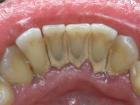|
Plaque leads to serious consequences
16-09-2009

The emergence and course of inflammatory periodontal diseases, primarily due to the influence of microbial dental plaque. Plaque is a soft, structured, attached to the surface of the tooth plaque, which is impossible to wash off with water. At 1 mg of plaque (the mass of the light water) contains approximately 10k bacteria.
The term Materia alba (white patches) denote the deposits on the teeth and gums, which in contrast to the raid, washed with water. The white plaque represents a whitish mass of unstructured, consisting of bacteria, leukocytes, and the remnants of the epithelium.
Other varieties of whitish deposits are held up leftover food. Although these deposits themselves are not pathogenic, but they represent a favorable place for the accumulation of plaque.
Results of control studies to establish the effects of the raid on the occurrence of inflammatory processes in periodontal tissues suggest that in the absence of hygienic oral care already after three days revealed the first signs of gum disease, and after 5-7 days of symptoms of acute or chronic gingivitis.
Experiments on animals have shown that the presence of plaque in the inflammation for a prolonged period of gingivitis can escalate into periodontitis – an inflammatory disease of the restraint apparatus of the tooth, accompanied by destruction of bone tissue of alveolar process jaws.
Duration localized above the gum, defined as supragingival plaque. If the gums are normal, the plaque is a thin-dental plaque, consisting of 75% of the partially anaerobic cocci and rods. Supragingival plaque, spread to the gingival sulcus, called poddesnevym bloom, the composition and structure of which differs from supragingival. Poor oxygen Wednesday poddesnevogo plaque contributes to the development of anaerobic microorganisms. In the species composition of microflora poddesnevogo plaque at healthy periodontal still dominated by microorganisms (cocci, etc.). When the ratio between mobile and fixed by microorganisms is 40-49:1.
When periodontal inflammation in poddesnevom raid increasing number of spindle-shaped and filamentous organisms, moving rods, spirochetes. Value of fixed and variable amounts of bacteria 1:1-3.
Poddesnevoy plaque is attached to a tooth surface of the structured part of the raid and freely located bacterial layer. Metabolism in bacteria poddesnevogo raid carried out with the participation of gingival fluid. With increasing depth of periodontal pockets of freely located bacterial plaque increases. It is believed that the development of inflammation in the periodontium due to the influence of gram-negative microorganisms.
Attached to the tooth surface of poddesnevogo plaque can form tartar. In connection with the presence in its composition of blood components poddesnevoy dental stone has a dark color, its hardness exceeds the hardness of supragingival dental calculus and its removal is difficult.
Despite the rough surface, as poddesnevoy and supragingival dental calculus do not contribute to the emergence of inflammatory processes in periodontitis. However tartar is distention surface for microorganisms. Careful study of the plaque with various diseases suggests that the pathogenicity of the raid depends on the species composition of microorganisms and products of their metabolism.
Parodontopatogennye plaque bacteria have properties capable of accelerating destruction of periodontal tissues. The enzymes produced by plaque bacteria, destroy intracellular substance or collagen reference frame, facilitating the penetration of microorganisms in the periodontal tissue. Among the key enzymes should be allocated collagenase, hyaluronidase, hondroitinsulfatazu and various types of proteases.
In addition, directly affect the periodontal tissue and final products of metabolism of bacteria, including ammonia, indole, hydrogen sulfide. Some of these products can be further disposed of other bacteria, which affects the composition of plaque.
Different bacteria produce specific toxins that are divided into endo-and exotoxins. Endotoxins are lipopolysaccharide from the walls of gram-negative microorganisms have the ability to induce an intense inflammatory defensive response. Exotoxins – is selected bacteria antigens, which include also leykotoksin, stimulating breakdown of polymorphonuclear granulocytes.
Inflammatory periodontal disease for a long time considered as a consequence of nonspecific infection of plaque bacteria (hypothesis of nonspecific infection of bloom). Proceeded from the fact that the composition of plaque determines the characteristics of inflammation in periodontitis.
The opening of specific types of bacteria, in combination with certain forms of inflammatory reactions, gave reason to suppose that there is a specific infection (specific plaque hypothesis), in accordance with Koch’s postulates. At the end of the last century, Robert Koch formulated four postulates, consisting of the fact that some infections depend on the presence of certain microorganisms isolated and their transfer to another organism causes a similar disease. Thus, a particular hypothesis about the origin of plaque claims that its composition has a decisive influence on the form of the disease. Now consider that in certain forms of periodontitis specificity of the bacteria is stimulated by the fact that the bacteria are in a raid egzogennym or develop under the influence of endogenous and crowd out other bacteria.
Therefore, inflammatory periodontal disease is now regarded as an opportunistic infection, depends not only on the presence of pathogenic microorganisms, but also on the environment conducive to their reproduction (eg, anaerobic niche, change the host resistance). The presence of certain types of bacteria, plaque stabilization is considered as a possible cause of periodontal destruction. Possible pathogens include: Actinobacillus actinomycetem comitans, Bacteroides forsythus, Eikenella corrodens, Fusobacterium nucleatum, Porphyromonas gingivalis, Selenomonas sp., Prevotella intermedia, and spirochetes.
By the assumption of stabilizers reckon: Actinomyces sp., Streptococcus mitis, Streptococcus sanguis II, Veil-lonella parvula, Capnocytophaga ochracea.
| |


